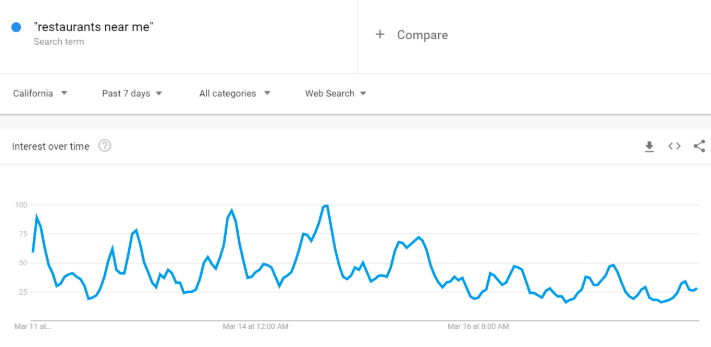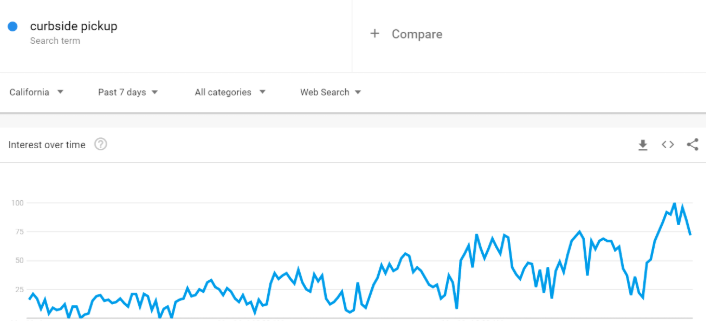19 Mar 7 Ways COVID-19 Is Affecting Search Traffic & How SEOs Can Respond via @Kammie_Jenkins
The question on just about every SEO’s mind right now is “How is the Coronavirus impacting SEO metrics?”
No surprise here. The answer, as always, is “it depends.”
Because search reflects human behavior, COVID-19 is affecting each industry differently.
For example, just as people are forming lines outside grocery stores, ecommerce sites that sell those same essentials are likely experiencing a huge surge in traffic.
This is also changing as news unfolds. For example, impressions and traffic for “non-perishable food” spiked when things like social distancing and shelter-in-place were announced.
As SEOs, we’ll need to respond accordingly.
I’ve been able to look at the data for a few sites across multiple verticals.
I’m also drawing from the information I’ve seen shared from other SEOs.
Based on what I’ve seen so far, here are seven ways COVID-19 seems to be affecting SEO metrics, and how we should consider responding.
1. Ecommerce Sites That Sell Essentials Are Surging Up
I’m sure I’m not the only one that’s seen ecommerce sites (at least the ones that sell essentials) with huge spikes in impressions and traffic.
That’s coming from people looking for toilet paper, hand sanitizer, Clorox wipes, thermometers… clearly product searches that are related to the pandemic.
This huge surge in demand, as well as product shortages, have even created new queries like “toilet paper near me” and “hand sanitizer near me.”
On the flip side, I’ve seen non-essentials like makeup experiencing drops in traffic, as well as products tied to travel, like luggage.
But things that are non-essentials one day can become essentials the next.
Around the same time gyms started closing, we saw impressions and traffic spike for things like “ring fit” and other indoor fitness options.
Or how about when employers started mandating work-from-home?
Yep – that’s around the same time surges for things like “office chair” and “office desk” started popping up in the query data.
How to Respond
Demand is high right now, but that demand has shifted largely to products that people need to avoid and/or deal with the pandemic.
Ecommerce SEOs might consider creating a segment of high-demand product pages, based on your impressions/traffic data, to watch closely. Crawl those pages for errors often.
Monitor log files to ensure they’re not serving search engine bots errors. Make them easy to find in the site navigation.
Watch the query data for those pages to ensure your content reflects the most up-to-date searcher intents.
2. Health & Wellness Sites Are Surging Up
The health and wellness vertical is no stranger to volatility.
Recently, Google has been cracking down on content that provides advice and information on things like medical issues (a “Your Money or Your Life” topic, according to their quality rater guidelines), holding it to a very high standard.
As a result of COVID-19, the health and wellness sites I’ve looked into are experiencing an overall surge in impressions and traffic.
It looks like that’s primarily being caused by queries like “coronavirus symptoms.”
On the flip side, people seem to be caring a lot less about things like intermittent fasting.
There also seems to be an uptick in queries for natural remedies like “antiviral herbs,” “antibacterial essential oils,” and “antiviral foods.”
How to Respond
Striving for expertise, authoritativeness, and trust with this type of content is more important now than ever.
People are turning to search engines to answer their medical questions, a responsibility that can’t be taken lightly.
3. Recipe Websites Appear to Be Experiencing a Slight Uptick
The recipe websites I’ve been able to look into so far have experienced an increase in impressions and clicks, although not quite as drastic as essentials retailers or health sites.
This is likely because more people are cooking at home as opposed to eating out.
This may continue to increase the longer restaurants are closed or operating at reduced capacity.
How to Respond
Use recipe structured data to enhance the way your recipes show up in search results to capture some of that increased demand for recipes.
Consider publishing or promoting recipes that utilize fewer ingredients and ingredients that are easier to get right now.
4. Travel Website Traffic Is All Over the Place
On the surface, you might think that travel websites are taking huge traffic hits due to travel restrictions and social distancing.
However, I’ve seen impressions and traffic surge up.
My first inclination was that this must be attributable to people looking to cancel, reschedule, or get refunds for their bookings.
Turns out, it seems to be a bit more complicated than that.
I’ve actually noticed impressions and traffic surges for queries like “cheap flights” – potentially because with all the cancelations, people are assuming airlines will be selling seats at super discounted prices.
Hotel queries seem to be trending down, especially in locations that are closed off like Disneyland or San Francisco.
Unsurprisingly, it seems like cruise-related queries are also trending down.
The travel industry is diverse, encompassing flights, hotels, cruises, and more.
The specific impact is going to vary depending on the sector.
Overall though, the travel industry is definitely feeling the impact.
How to Respond
As Kevin Gibbons said, travel companies are likely largely shifting to customer support and reputation management, not acquisition.
1) Some sectors are clearly more affected than others:
– Travel is badly hit, focus is on managing customer support / reputation, not acquisition.
– Retail, store closures are now wide-spread, there's a shift to online, but mindful of changing buying behaviours / stock levels.— Kevin Gibbons (@kevgibbo) March 18, 2020
Travel SEOs can help this effort by closely monitoring their query data to see where their audience’s demand is shifting, and using that to inform support and PR efforts.
5. Publisher Websites Are in Incredibly High Demand
This will surprise no one, but publisher websites are experiencing huge surges in impressions and traffic.
People are looking for updates in all forms, from “coronavirus map” to how coronavirus is impacting the stock market.
One thing’s for sure, we’ve all been glued to the news as of late (for better or for worse).
How to Respond
As journalists continue to report on coronavirus news and updates, publisher SEOs can offer support in a few ways.
They can:
- Watch their log files to ensure AMP pages aren’t serving errors.
- Monitor pages by publish date to make sure search engine bots are crawling new pages as soon as possible.
- Use search data to inform where the public interest is at any given time.
- Coordinate evergreen content to compensate for seasonal and news-based volatility.
6. Restaurants Are Having to Pivot
While I haven’t been able to look at any data from restaurant sites directly, the effects are apparent.
In many locations, restaurants are operating at limited capacity.
In many others, (including my home county of Los Angeles) restaurants and bars are closed completely.
That means queries local restaurants may have relied on pre-COVID are trending down.


However, interest in alternatives like “curbside pickup” (an option many restaurants are starting to offer), is going way up.


Third-party delivery services like UberEats, Postmates, DoorDash, and Grubhub are also trending up.
Thankfully, those companies are temporarily waiving fees they charge some restaurants in order to help them stay afloat during this time.
How to Respond
If you do local SEO for a restaurant that’s had to close due to COVID-19, use holiday hours on Google My Business (GMB) to indicate that you’re closed instead of removing your store hours completely (tip courtesy of Masaki Okazawa).
GMB tip if you're an SMB that has to close bc of COVID-19: Use Holiday Hours to indicate that you are closed instead of removing your store hours completely.
Removing hours marks your business listing as "Open Now", which can mislead customers in times of panic. pic.twitter.com/9NZjsDtw9m
— Masaki Okazawa (@saksters) March 18, 2020
You can also add a GMB Question & Answer around your restaurant’s status during COVID-19 and get as many people as possible to upvote it so it appears as the main question in your knowledge panel (tip courtesy of Darren Shaw).
A1: Suggestion 4 of 4: Add a top Question & Answer about your status, then get many people to upvote it so it appears as the main question right on your knowledge panel #CallRailChathttps://t.co/RkoNsJXKqG
— Darren Shaw (@DarrenShaw_) March 17, 2020
Dana DiTomaso is also recommending that local businesses use Google Posts to point to any updates.
A1 We are recommending that people use Google Posts to point to any updates, here is an example from a client of ours – this post leads to their blog post about their response. #CallRailChathttps://t.co/Ieq0Hzb6lipic.twitter.com/Xe1JXHI4vw
— Dana DiTomaso (@danaditomaso) March 17, 2020
7. Volatility Is Present in Websites Across the Board
Times are uncertain, but one thing’s for sure – the current volatility is impacting just about every website I’ve looked into.
In these times of volatility, empathy and your own website’s data are king.
Benchmarks can be helpful, but make sure you’re looking at your own query data.
This will give you a window into your audience’s needs.
Are you meeting those needs, or not?
At a time when brands are having to reduce their campaign spend, there’s one acquisition channel that doesn’t turn off during budget cuts… organic search.
Although things are currently in a state of major flux, SEO may be more important now than ever.
More Resources:
- 5 Completely Sane Reasons Why You Shouldn’t Stop SEO Efforts During COVID-19
- 13 Ways Businesses Can Use SEO & Marketing to Combat Coronavirus Impact
- How to Keep SEO Clients and Survive in Time of Crisis
Image Credits
Screenshots taken by author, March 2020
Sorry, the comment form is closed at this time.